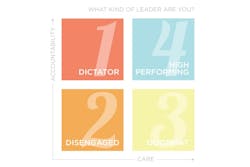Balancing Care and Accountability
If you’re a shop owner or manager, your leadership tendencies might get out of balance between empathy and accountability. But holding both qualities in creative tension actually accomplishes far more than settling for the either-or of accountability or care.
Think of it this way: Two axes, one vertical and one horizontal. The horizontal, or X-axis, represents care, with the far right being the most care and the far left being the least. The Y-axis stands for accountability, with the top being the most accountability and the bottom being the least.
This creates four quadrants:
1. The top left quadrant at its most extreme points represents what I call the “dictator style.” Dictators do not care about people. They use them and hold them to very high standards that, if not met, someone is severely punished. Dictators are not interested in carrots (incentives). They motivate with the stick (threat of punishment).
2. The bottom left quadrant is the “disengaged style.” This is a leader that neither holds people accountable nor cares about them. Their philosophy is to just let the chips fall where they may and hope for the best.
3. The bottom right quadrant is the “doormat style.” They care about people, but never seem able to hold them accountable. They do not demand much from their team but they are full of understanding and empathy.
4. In the top right quadrant are the high-performing leaders. They both care about the people that work for them and hold them to a very high standard. The best leaders, teachers and coaches live far out into the top right quadrant. They are always growing their ability to both care for people and simultaneously hold them accountable.
I recently drew out these quadrants for our leadership team and asked everyone where they thought we were as an organization and as leaders. For us, the resounding and clear answer was that we were squarely in the “doormat” quadrant. With no disagreement or even a bit of contradiction, they all said, “High care, low accountability. We are doormat leaders!”
I was faced with the realization that I had created a shop culture that made our leaders vulnerable to being taken advantage of. We have created a very caring culture—a good thing—but have not done the hard work of creating a high degree of expectation or accountability for results.
So what did we do? Our initial approach has been to make “Controls and Culture Change” the theme of our goals for this quarter. Culture change always happens slowly and we have learned that rushing it is counterproductive. So a slow and steady march toward upping our controls and changing our culture over the next several months is the approach we have chosen.
We are writing a lot of things down and reviewing them in our leadership and shop meetings. By the year’s end, the plan is for every employee to have a written job description, something we haven’t had before. Along with that, we are creating individualized work and development plans so all employees—managers, estimators and techs—will simultaneously be held accountable and developed.
We are also documenting all of our processes, systems and other “how we do things around here” information in an operations manual. Lastly, we recently posted a few specific policies in our office on a handful of urgent things we needed to change so our customers do not take advantage of us. For example, we will no longer use “prepped to paint” parts that customers bring in themselves.
All of this came from the simple exercise of asking staff where we stand as leaders. If you want your shop to be a top performer and you personally want to be the kind of leader that people love to work for, you will need to work at being caring while holding people to a high standard. And with self-awareness, patience, and a willingness to learn and change, it’s something we all can achieve.




